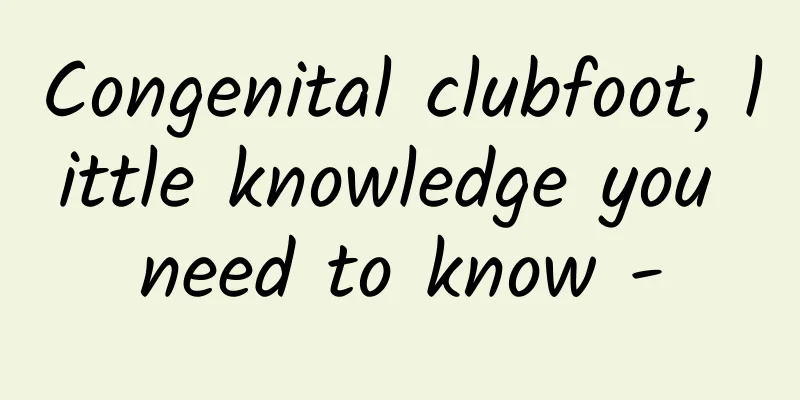Congenital clubfoot, little knowledge you need to know -

|
Patient: Doctor, can you see whether my baby has clubfoot? Doctor: Parents, please don't worry. Let's first clarify what clubfoot is. We generally call it congenital clubfoot, which is a general term for a group of complex deformities, including high arches, adduction, inversion and drooping of the "little feet" in their natural state, and the appearance is similar to a "horse hoof". The incidence of this deformity is about 0.9-7‰, more boys, with a male-to-female ratio of about 2:1, and about half of the children will have bilateral disease. High arches are usually caused by contracture of the plantar fascia and ligaments, and the hindfoot moves closer to the forefoot, resulting in a high arch. Adduction deformity is caused by the axial deviation of the talus, which causes the talonavicular joint to form an adduction deformity after inward deviation. At the same time, the longitudinal axis of the talus is parallel to the calcaneus, and the subtalar joint has adaptive changes, which looks like a varus deformity. Finally, the shortening of the calf muscles and the short Achilles tendon cause foot drop deformity. Patient: How did my baby get this disease? Doctor: This disease usually has no specific cause, it may be the combined effect of multiple factors. When the fetus is developing in the uterus, the position of the foot is not good, and the uterine wall squeezes it, resulting in equinovarus deformity. Abnormal development of the body's own nerves, muscles and bones can also lead to foot bone deformity and muscle imbalance, resulting in adaptive changes in joints and soft tissues. Patient: Will it affect my baby’s walking in the future? Doctor: Without intervention, as the child grows, the foot deformity will affect the weight-bearing capacity of the entire leg. The reduced weight-bearing capacity of the leg will affect the development of the leg muscles, causing the lower limbs to become thinner and shorter, and the feet to become smaller. Generally, the difference between the two legs is within 1 cm. The child's walking posture is abnormal, and the weight falls on the skin on the outside of the dorsum of the foot, which will cause calluses. Patient: Then we need to get treatment as soon as possible. My baby is three months old. Is it too late? Does he need surgery? Doctor: The treatment effect is good within 1 year old, especially the intervention within 6 months, which will basically not affect the child's future walking. The current internationally common treatment method is the Ponseti method. After more than 40 years of clinical practice, the method is mature and reliable. Through multiple plaster corrections and braces, some children with plantar flexion deformity only need minor surgery to lengthen the Achilles tendon, and the treatment success rate is over 90%. During treatment, professional manual correction and plaster fixation are first used to gradually correct the high arch, adduction, and varus deformities, and the plantar flexion will also be gradually improved. Generally, the plaster is changed once a week, and after 4 to 5 consecutive adjustments, the brace can be worn. This brace can be adjusted according to your baby's condition. The horizontal bar should be shoulder-width apart, and the affected foot should be abducted 60° to 70°, and the healthy foot should be abducted 30° to 40°. The brace should be worn for at least 23 hours a day for the first three months, and can be removed briefly for personal cleaning. Later, the brace can be worn when the baby is asleep, ensuring 14 to 16 hours of wearing time per day. To prevent recurrence, we usually recommend wearing it until about 4 years old. In addition to the above treatments, you also need to bring your baby to the rehabilitation department for rehabilitation training, and conduct comprehensive training on the muscle strength, balance ability, and gait of the lower limbs to help the baby recover faster. Patient: I understand. Thank you, doctor! Doctor: To sum up, the deformity characteristics of clubfoot include high arch, adduction, inversion, and plantar flexion. Through reduction, about 5 times of plaster fixation, and wearing of braces for about 3 years, plus persistent rehabilitation training, the "little feet" will be gradually corrected and restored to normal. |
<<: 【Love Ear】Healthy ears·Scientific ear protection
Recommend
Is a 40-day menstrual cycle normal?
Recently, many female friends often ask me that t...
Is aloe vera suitable for indoor cultivation? How to grow lucky bamboo indoors?
Many people like to grow flowers, and some even h...
Digiday: Instagram Marketing Budget and Confidence Survey 2022
Digiday's survey found that, like Facebook, I...
What is the difference between Lego toys and other toys? How to teach children to play Lego?
Lego is a toy that is the original creator of toy...
Did you know that you can eat oranges when you have dysmenorrhea?
Orange is a very common fruit. It has the effect ...
What to eat to maintain the uterus and ovaries
We all know that the uterus is a very important r...
What to do if you have a bicornuate uterus
The uterus is an important reproductive organ in ...
Why is my period painful?
Menstruation is a physiological reaction that eve...
What is the cause of brown vaginal discharge and vaginal itching?
Many women have experienced brown vaginal dischar...
Insights into professional gaming phones: Black Shark ranks first in market share, with young male users as the main force
In the first quarter of 2020, with the hot develo...
What are neck exercises?
Nowadays, many people have some problems with the...
What are the symptoms of acute vulvar ulcer?
In today's society, the incidence of gynecolo...
What is the normal amount of vaginal discharge for girls?
A girl's leucorrhea can indirectly reflect th...
Why do I have blood clots and meat-like things during my period?
Menstruation is a physiological phenomenon unique...
What to do if your cervix is atrophic
I believe that everyone is familiar with cervical...









